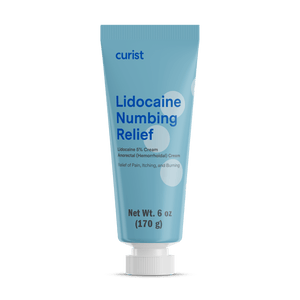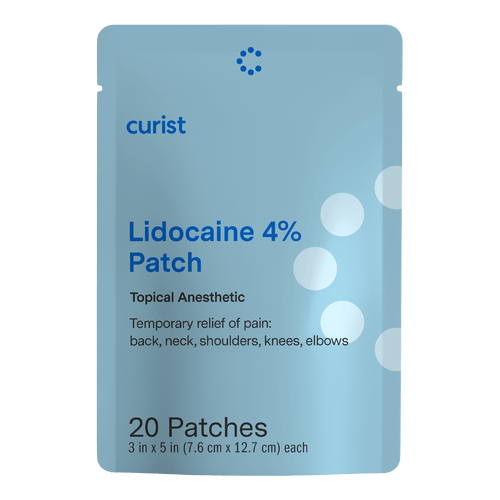By Sophie Kang, Ernest Mario School of Pharmacy at Rutgers University
Curist delivers over-the-counter medicines to your door at a fraction of the price of traditional brands. We hope everyone stays safe and healthy during this time.
Diclofenac gel and ibuprofen tablets are popular options for pain relief. In this article, we will review both products and compare their similarities and differences.
Is Diclofenac the Same as Ibuprofen?
No, diclofenac and ibuprofen are not the same. Diclofenac and ibuprofen are both classified as nonsteroidal anti-inflammatory drugs (NSAID) that are used to relieve pain caused by inflammation, but differ in their uses, formulations, and ability to relieve pain. Diclofenac is more potent than ibuprofen, so a smaller amount of diclofenac is needed to relieve pain compared to ibuprofen. Diclofenac and ibuprofen are both commonly used for arthritis-related joint pain, which includes the hands, wrists, elbows, ankles, knees, and feet. Diclofenac is available in a wide variety of formulations, including gels, patches, solutions, capsules, and tablets. Ibuprofen also comes in multiple forms, including solutions, suspensions, capsules, and tablets.
To learn more about NSAIDs and the treatment of arthritis, check out this Curist article What Are the Best Anti-Inflammatory Drugs & NSAIDS for Arthritis?.
What is Diclofenac Gel and How Does It Work?
Diclofenac is an NSAID that works by reducing the levels of hormones called prostaglandins, which cause inflammation and pain responses. Diclofenac gel can be applied to a specific area to reduce inflammation and pain. Diclofenac gel has multiple uses, and is commonly used for arthritis pain and local joint or muscle injuries. Diclofenac gel can be applied to joints such as the hands, wrists, elbows, feet, ankles, or knees and reduces arthritis-related joint pain in that area. Diclofenac gel comes in multiple strengths, including 1% and 3%, but the 1% gel is specifically for arthritis-related joint pain.
To learn more, diclofenac 1% gel is available over-the-counter (OTC) at Curist without a prescription.
What are Ibuprofen Tablets and How Do They Work?
Ibuprofen is an NSAID that works by blocking the production of chemicals in the body that cause pain and inflammation. Ibuprofen can be used to treat pain, including headaches, toothaches, muscle pain, and menstrual cramps. Ibuprofen is also used for fevers, inflammatory diseases, and rheumatoid disorders such as arthritis. Some common brands of ibuprofen tablets available OTC that you may have heard of include Advil and Motrin.
How are Diclofenac Gel and Ibuprofen Tablets Similar?
Diclofenac and ibuprofen are both NSAIDs, which relieve inflammation and pain caused by certain hormones in the body. Diclofenac gel and ibuprofen tablets can both be used to relieve arthritis joint pain. Both diclofenac gel and ibuprofen tablets are available OTC and have higher strengths that are prescription-only. Diclofenac gel 1% is available OTC at Curist for a more affordable price.
What are the Key Differences Between Diclofenac Gel vs Ibuprofen Tablets?
Difference Between Diclofenac Gel vs Ibuprofen Tablets: Indications
Diclofenac gel is effective at treating arthritis-related joint pain and is only applied to affected parts of the body. If you apply diclofenac gel 4 times daily, you should experience pain relief within 7 days of continued use. Diclofenac gel can also be used for muscle pain and actinic keratosis, which is an area of thick, scaly skin caused by sun exposure.
Ibuprofen tablets are also used to treat arthritis-related joint pain. In addition to osteoarthritis, ibuprofen tablets can also be used to treat fevers, menstrual pain, and any mild or moderate pain you may experience. Ibuprofen tablets are taken by mouth, and provide pain relief within 30-60 minutes.
Difference Between Diclofenac Gel vs Ibuprofen Tablets: Formulation
Diclofenac gel is applied to the area where you are experiencing pain and is not taken by mouth. Because diclofenac gel is only applied to a specific area where you are experiencing pain, diclofenac will only relieve pain and reduce inflammation in that area.
Ibuprofen tablets are taken by mouth and can work throughout the body to reduce inflammation and pain.
Difference Between Diclofenac Gel vs Ibuprofen Tablets: Side Effects
Some side effects you may experience with diclofenac include peeling or flaking of skin, itchiness or a skin rash, and/or dry skin at the application site.
Because ibuprofen tablets are taken by mouth, the side effects differ from diclofenac gel. Gastrointestinal symptoms have been found to be more common with ibuprofen tablets compared to diclofenac gel. Side effects of ibuprofen tablets include constipation, diarrhea, stomach pain, upset stomach, vomiting, heartburn, gassiness, and dizziness. If these side effects bother you or do not go away, be sure to reach out to your doctor or get medical help.
How Should Diclofenac Gel Be Used?
Diclofenac gel should be used on the skin only and should not be taken by mouth. Make sure to keep the gel out of your mouth, eyes, and nose, as the gel may cause a burning sensation. Wash your hands thoroughly before and after using the gel. Clean the area where you will be applying the gel, and make sure not to use any other products such as sunscreen, insect repellant, or other drugs on the area where you will be applying the gel.
When applying the gel, place a thin layer on the skin and gently rub in the gel. Let the gel dry for at least 10 minutes before covering the area with clothing or gloves. Take care not to expose the treated area to any water for at least 1 hour after application. If applying the gel on the hand, do not wash your hands for at least 1 hour after applying the gel. If using the Curist brand of diclofenac, make sure to use the provided dosing card, which will help you measure the proper amount of gel to apply to specific areas of the body.
How Should Ibuprofen Tablets Be Taken?
Ibuprofen tablets should be taken by mouth with a full glass of water. Ibuprofen tablets can be taken with or without food, however, if you feel that the tablets are causing an upset stomach, you can take ibuprofen tablets with food. It is important not to take ibuprofen tablets for more than 10 consecutive days unless instructed otherwise by your doctor. This is because ibuprofen, like other oral NSAIDs, has a risk of severe gastrointestinal side effects including bleeding and ulcer formation in the stomach or intestines if taken for longer than 10 days in a row.
Is Diclofenac Gel Stronger than Ibuprofen Tablets? Are Ibuprofen Tablets Stronger than Diclofenac Gel?
Diclofenac is stronger than ibuprofen, however, both diclofenac gel and ibuprofen tablets are effective in treating arthritis-related joint pain. Oral and topical NSAIDs offer the same amount of pain relief. Topical NSAIDs such as diclofenac gel that are only applied to the site of pain should be tried before taking oral NSAIDs (by mouth). Oral NSAIDs like ibuprofen tablets should be used at the lowest dose and for the shortest treatment period possible.
What is Better for Arthritis Pain: Diclofenac Gel or Ibuprofen Tablets?
For treating arthritis pain, it is generally recommended to try topical NSAIDs (such as diclofenac gel) first, which are products applied to the area of the body experiencing pain, before moving to oral NSAIDs (such as ibuprofen tablets), which are taken by mouth. Using a topical NSAID is thought to have reduced side effects compared to oral NSAIDs, since topicals are only applied to one area of the body. Oral and topical NSAIDs offer equivalent short-term arthritis pain relief.
Both diclofenac gel and ibuprofen tablets are effective in treating arthritis pain. Diclofenac gel is approved for relief of arthritis pain in the hands, wrists, elbow, feet, ankles, or knees. Because diclofenac gel is only recommended for the aforementioned specific joints, ibuprofen tablets may provide more relief for other areas of pain or muscle soreness. Ibuprofen tablets may also be preferred over diclofenac gel for arthritis pain in the hands due to practical benefits, such as not requiring frequent handwashing before application and having to avoid exposure to water afterward.
To shop diclofenac gel online at a more affordable price, check out Curist Arthritis Relief.
What is Better for Arthritis Pain if I Have Stomach Issues: Diclofenac Gel or Ibuprofen Tablets?
Diclofenac gel is better than ibuprofen tablets if you have stomach issues. Topical NSAIDs (such as diclofenac gel) are only applied to the surface of the body experiencing pain, penetrate the skin only where applied, and have fewer gastrointestinal side effects. More stomach and intestine side effects are seen with ibuprofen tablets, which are taken by mouth and travel to the stomach before being absorbed into the bloodstream. Topical NSAIDs such as diclofenac gel are not absorbed in the stomach, and so cause fewer gastrointestinal issues.
Can I Use Diclofenac Gel and Ibuprofen Tablets Together?
It is not recommended to use diclofenac gel and ibuprofen tablets together since they work the same way and can interact. Taking two NSAIDs together can lead to increased risks of side effects, in particular, gastrointestinal side effects such as a stomach or intestinal bleeding or ulcers. If you are not experiencing pain relief with one NSAID, you can consider switching to a different one for pain relief.












